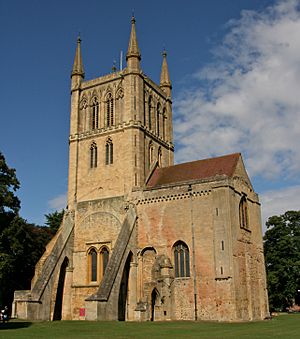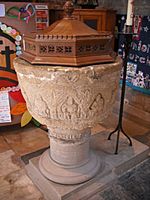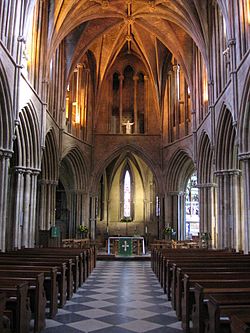Pershore Abbey facts for kids
Quick facts for kids Pershore Abbey |
|
|---|---|

Pershore Abbey
|
|
| Denomination | Church of England |
| Churchmanship | Broad Church |
| Website | pershoreabbey.org.uk |
| History | |
| Dedication | Holy Cross |
| Administration | |
| Parish | Pershore |
| Diocese | Worcester |
| Province | Canterbury |
Pershore Abbey is a historic church in Pershore, Worcestershire, England. It started as an Anglo-Saxon monastery a very long time ago. Today, it is an Anglican parish church known as the Church of the Holy Cross.
Contents
History of Pershore Abbey
How the Abbey Began
The story of Pershore Abbey starts way back in the 7th century. Some old records suggest that a monastery was founded here by King Æthelred of Mercia (who ruled from 675-704) or his brother Oswald. These early records are a bit unclear because many original documents were lost.
One old paper, from the 14th century, talks about King Æthelred giving a lot of land (about 36,000 acres!) to start the monastery. This huge amount of land was meant to show how important the area was. Historians think this document might have been written later, but it probably used some real information from the past.
The monastery was active in the 9th century. Kings like Coenwulf of Mercia and Burgred supported it. This shows that Pershore was an important religious place even in those early times.
The Abbey's New Start
In the 10th century, during the time of King Edgar (959-975), many monasteries in England were reformed. This was a time when religious life was made stronger and more organized. Pershore Abbey was one of the places that got a new start.
A monk named Byrhtferth wrote around the year 1000 that Bishop Oswald of Worcester helped set up seven monasteries, including Pershore. The first leader (called an abbot) of the reformed Pershore Abbey was Foldbriht.
There's a special document from 972 that says King Edgar gave new lands and special rights to Pershore. This document is very fancy, but historians have debated if it's completely real or if parts were added later. It might have been created after a big fire in 1002, when many original records were lost.
Some historians from the 12th century, like William of Malmesbury, believed that a powerful person named Æthelweard helped found the abbey during King Edgar's reign. They also said he brought some holy relics (like bones or items from a saint) of Saint Eadburh of Winchester to Pershore.
However, the abbey faced tough times after King Edgar died. It seems to have lost some of its wealth and land. An earl named Ælfhere might have taken some of the abbey's lands. This was a period of conflict between powerful leaders, and some monasteries suffered.
A Second New Beginning
Pershore Abbey faced another big challenge around 1002. According to old stories, a fire destroyed the abbey, and the monks left. This fire caused the loss of most of the abbey's old records.
Luckily, a rich nobleman named Odda of Deerhurst (who died in 1056) became a great helper for Pershore. He gave back many lands and even granted new ones. Thanks to him, the monastery became active again by the 1020s. Odda and his brother were both buried at Pershore, showing their strong connection to the abbey.
By the time Odda died, the abbey owned a lot of land. But after his death, about two-thirds of this land was taken away. It was given to Edward the Confessor's new church in Westminster.
In the early 12th century, Pershore Abbey claimed to have some relics of Saint Eadburh of Winchester. She was a saintly daughter of King Edward the Elder. Her relics had been moved several times, and Pershore believed they had some of them.
Later Years and Changes
The main church building we see today started being built around 1100. In the 14th century, a generous person named Adam de Harvington helped the abbey a lot.
However, in 1539, a big change happened in England called the Dissolution of the Monasteries. This is when King Henry VIII closed down many monasteries across the country. Pershore Abbey was also dissolved.
After the Dissolution, parts of Pershore Abbey church were torn down. Only the tower, the choir (where the main services are held), and the south transept (a part of the church that sticks out) remained. Luckily, these parts continued to be used as a parish church for the local community.
Over the years, more changes happened. In 1686, the north transept collapsed, and a wall was built in its place. Later, in the 1860s, a famous architect named George Gilbert Scott restored the church. He removed a floor in the bell tower, opening up the beautiful lantern tower to show its detailed carvings. Scott thought this lantern tower was one of the best in the country! The tower's pointy tops (pinnacles) were added in 1871.
What You See Today

The church building you see now is only a small part of the huge original abbey. It is a very important historic building, listed as Grade I.
In 1994, major repairs were done to make sure the south transept was stable and to strengthen its roof. The tower and its pinnacles were also repaired. They even put in a new heating system under the floor!
The Abbey Bells
Pershore Abbey has a set of eight bells. Six of these bells were made by Abraham Rudhall in 1729. The smallest bell was made in 1814. The fourth bell was recast (melted down and made again) in 1897 because it was cracked. The largest bell is very heavy, weighing about 2,856 pounds! It makes a deep D note.
The room where the bell ringers stand is quite unique. It's a metal "cage" hanging high up above the main part of the church. To get there, you have to climb two spiral staircases, walk through the roof, squeeze through a narrow passage, and then go up a see-through iron staircase!
Each bell has a special message carved into it:
- 1. "Joseph Martin and Thomas Evans churchwardens 1814"
- 2. "Peace and good neighbourhood"
- 3. "Abr Rudhall of Gloucester cast all of us"
- 4. "Barwell Founder Birmingham. Prosperity to the Church of England 1729 Recast 1897"
- 5. "Prosperity to all our benefactors A R 1729"
- 6. "Walter Marriott and Edmund Gale churchwardens A R 1729"
- 7. "Richard Roberts Esq John Yeend and Thomas Ashfield Gent[leme]n trustees A R 1729"
- 8. "I to the Church the living call: And to the grave do summon all"
The Baptismal Font
Around 1840, the abbey got a new baptismal font (a basin used for baptisms). The original Norman font, which was very old, was moved outside into the churchyard. For a while, it was even used as a cattle trough! Later, it was used in a garden.
In 1912, the old font was brought back to the abbey. It was placed on a new base designed by Harold Brakspear. This old font is decorated with a pattern of arches, and inside these arches are figures of Christ and his Apostles.
Abbots of Pershore Abbey
The abbots were the leaders of the monastery. Here are some of the people who held this important role:
| Name | In office | Comments |
|---|---|---|
| Foldbriht | c. 970 – 988 | |
| Brihtheah (Brihteah) | ? – 1033 | Later became the bishop of Worcester. |
| Edmund | 1058–1085 | |
| Thurstan | 1085–1087 | |
| Guy | ? – 1102, then ? – 1136/7 | Was removed from office but later came back. |
| Simon | 1175–1198 | |
| Master Anselm | 1198–1203 | |
| Gervase | 1204–1234 | |
| Roger de Rudeby (Rudby) | 1234–1251 | |
| William of Harvington | 1307–1340 | |
| John Stonywell | 1526–1539 x 40 | He was the abbot when the abbey was closed down. |
The Abbey Organ
The abbey used to have a large organ built in 1872. It was replaced with an electronic organ. However, a brand new pipe organ, costing around £850,000, has been ordered from Italy.
Many talented musicians have been organists and masters of music at Pershore Abbey over the years.
Abbey Grounds
The original monastery buildings were located to the southwest of the church. Their buried foundations were found during an archaeological dig in 1929.
After the Dissolution of the Monasteries, these buildings were torn down. A house called Abbey House was built on the site in the 1830s. In 1910, the owner, Henry Wise, gave the house to a group of Anglican monks. When some of these monks changed to Roman Catholicism in 1913, the house was returned to Wise. He then gave it to the monks who remained Anglican. The monks eventually sold the house in 1947, and it was demolished to make way for new homes and parkland.
Gallery








